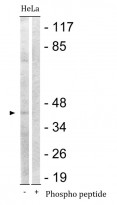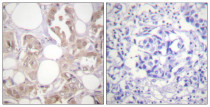ARG66661
anti-CDK7 phospho (Thr170) antibody
anti-CDK7 phospho (Thr170) antibody for IHC-Formalin-fixed paraffin-embedded sections,Western blot and Human
Overview
| Product Description | Rabbit Polyclonal antibody recognizes CDK7 phospho (Thr170) |
|---|---|
| Tested Reactivity | Hu |
| Tested Application | IHC-P, WB |
| Host | Rabbit |
| Clonality | Polyclonal |
| Isotype | IgG |
| Target Name | CDK7 |
| Antigen Species | Human |
| Immunogen | Phosphospecific peptide around Thr170 of Human CDK7. |
| Conjugation | Un-conjugated |
| Alternate Names | CDK-activating kinase 1; Cell division protein kinase 7; Serine/threonine-protein kinase 1; CAK1; MO15; CDKN7; EC 2.7.11.22; STK1; TFIIH basal transcription factor complex kinase subunit; EC 2.7.11.23; p39 Mo15; 39 kDa protein kinase; p39MO15; Cyclin-dependent kinase 7; HCAK |
Application Instructions
| Application Suggestion |
|
||||||
|---|---|---|---|---|---|---|---|
| Application Note | * The dilutions indicate recommended starting dilutions and the optimal dilutions or concentrations should be determined by the scientist. | ||||||
| Observed Size | ~ 40 kDa |
Properties
| Form | Liquid |
|---|---|
| Purification | Affinity purification with immunogen. |
| Buffer | PBS, 0.02% Sodium azide, 50% Glycerol and 0.5% BSA. |
| Preservative | 0.02% Sodium azide |
| Stabilizer | 50% Glycerol and 0.5% BSA |
| Concentration | 1 mg/ml |
| Storage Instruction | For continuous use, store undiluted antibody at 2-8°C for up to a week. For long-term storage, aliquot and store at -20°C. Storage in frost free freezers is not recommended. Avoid repeated freeze/thaw cycles. Suggest spin the vial prior to opening. The antibody solution should be gently mixed before use. |
| Note | For laboratory research only, not for drug, diagnostic or other use. |
Bioinformation
| Database Links | |
|---|---|
| Gene Symbol | CDK7 |
| Gene Full Name | cyclin-dependent kinase 7 |
| Background | The protein encoded by this gene is a member of the cyclin-dependent protein kinase (CDK) family. CDK family members are highly similar to the gene products of Saccharomyces cerevisiae cdc28, and Schizosaccharomyces pombe cdc2, and are known to be important regulators of cell cycle progression. This protein forms a trimeric complex with cyclin H and MAT1, which functions as a Cdk-activating kinase (CAK). It is an essential component of the transcription factor TFIIH, that is involved in transcription initiation and DNA repair. This protein is thought to serve as a direct link between the regulation of transcription and the cell cycle. [provided by RefSeq, Jul 2008] |
| Function | Serine/threonine kinase involved in cell cycle control and in RNA polymerase II-mediated RNA transcription. Cyclin-dependent kinases (CDKs) are activated by the binding to a cyclin and mediate the progression through the cell cycle. Each different complex controls a specific transition between 2 subsequent phases in the cell cycle. Required for both activation and complex formation of CDK1/cyclin-B during G2-M transition, and for activation of CDK2/cyclins during G1-S transition (but not complex formation). CDK7 is the catalytic subunit of the CDK-activating kinase (CAK) complex. Phosphorylates SPT5/SUPT5H, SF1/NR5A1, POLR2A, p53/TP53, CDK1, CDK2, CDK4, CDK6 and CDK11B/CDK11. CAK activates the cyclin-associated kinases CDK1, CDK2, CDK4 and CDK6 by threonine phosphorylation, thus regulating cell cycle progression. CAK complexed to the core-TFIIH basal transcription factor activates RNA polymerase II by serine phosphorylation of the repetitive C-terminal domain (CTD) of its large subunit (POLR2A), allowing its escape from the promoter and elongation of the transcripts. Phosphorylation of POLR2A in complex with DNA promotes transcription initiation by triggering dissociation from DNA. Its expression and activity are constant throughout the cell cycle. Upon DNA damage, triggers p53/TP53 activation by phosphorylation, but is inactivated in turn by p53/TP53; this feedback loop may lead to an arrest of the cell cycle and of the transcription, helping in cell recovery, or to apoptosis. Required for DNA-bound peptides-mediated transcription and cellular growth inhibition. [UniProt] |
| Cellular Localization | Nucleus. Cytoplasm. Cytoplasm, perinuclear region. Note=Colocalizes with PRKCI in the cytoplasm and nucleus. Translocates from the nucleus to cytoplasm and perinuclear region in response to DNA-bound peptides. [UniProt] |
| Calculated MW | 39 kDa |
| PTM | Phosphorylation of Ser-164 during mitosis inactivates the enzyme. Phosphorylation of Thr-170 is required for activity. Phosphorylated at Ser-164 and Thr-170 by CDK2. [UniProt] |
Images (2) Click the Picture to Zoom In
-
ARG66661 anti-CDK7 phospho (Thr170) antibody WB image
Western blot: HeLa cells treated with Calyculin A (50 nM for 30 min). Cell lysates stained with ARG66661 anti-CDK7 phospho (Thr170) antibody. The lane on the right is blocked with the phospho peptide.
-
ARG66661 anti-CDK7 phospho (Thr170) antibody IHC-P image
Immunohistochemistry: Paraffin-embedded Human breast carcinoma tissue stained with ARG66661 anti-CDK7 phospho (Thr170) antibody. The picture on the right is blocked with the phospho peptide.







